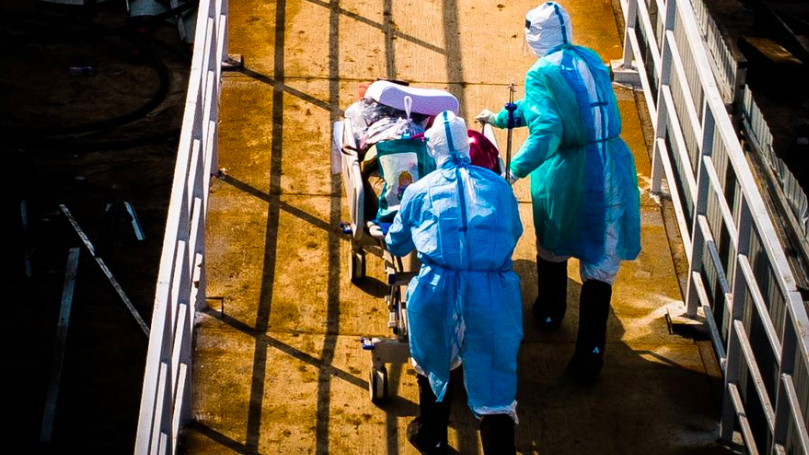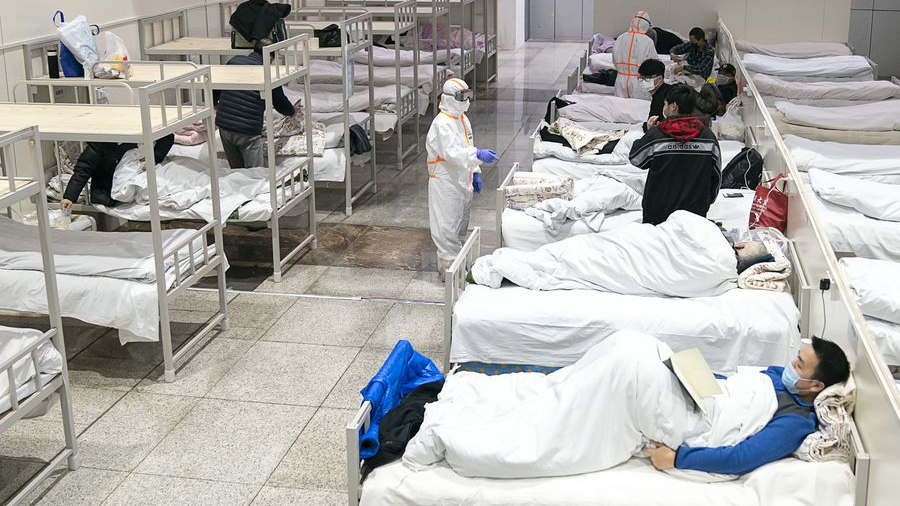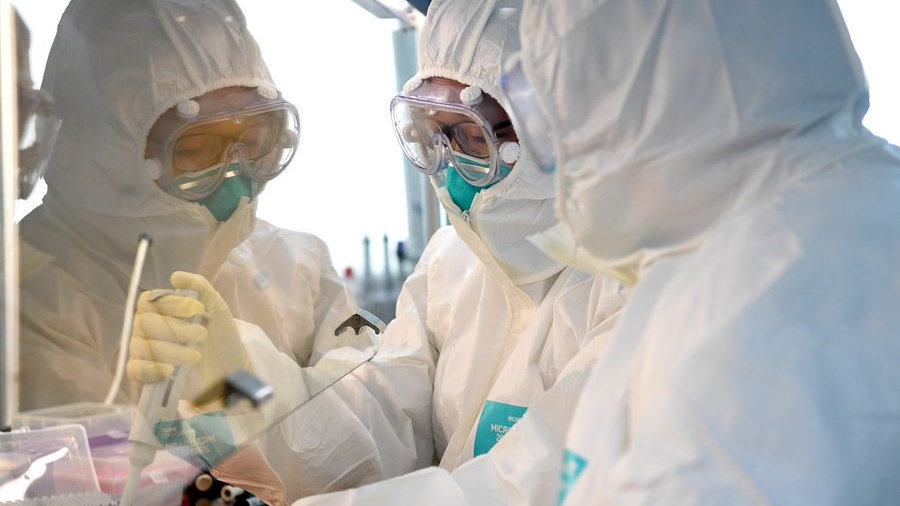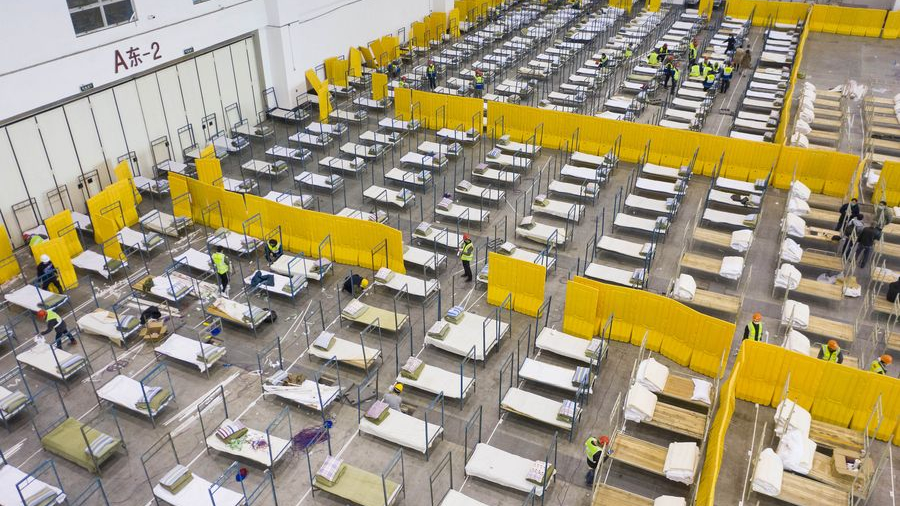
Medical workers help the first batch of patients infected with the novel coronavirus move into their isolation wards at Huoshenshan Hospital in Wuhan, central China's Hubei Province, February 4, 2020. /Xinhua Photo
Medical workers help the first batch of patients infected with the novel coronavirus move into their isolation wards at Huoshenshan Hospital in Wuhan, central China's Hubei Province, February 4, 2020. /Xinhua Photo
As more hospitals and qualified third-party institutions join the effort, Wuhan is now able to test nearly 4,200 nucleic acid samples per day, local authorities said.
Apart from provincial and municipal centers for disease control and prevention, 25 hospitals and 12 qualified third-party institutions are able to conduct nucleic acid testing, according to the Hubei Provincial Health Commission.
As of Monday, the novel coronavirus nucleic acid testing capability of Wuhan had increased to 4,196 samples per day from an initial 200 samples.
The city is not only improving its nucleic acid testing capability, but also adding more testing methods to diagnose patients as soon as possible so as to control possible transmission and offer the patients proper treatment.

Patients infected with the novel coronavirus are seen at a makeshift hospital converted from an exhibition center in Wuhan, central China's Hubei Province, February 5, 2020. /Xinhua Photo
Patients infected with the novel coronavirus are seen at a makeshift hospital converted from an exhibition center in Wuhan, central China's Hubei Province, February 5, 2020. /Xinhua Photo
Two other public facilities have also been turned into hospitals, with a total of 2,800 beds. They started to take in patients with mild symptoms late Wednesday.
After 10 days' work, Leishenshan Hospital, with a capacity of 1,600 beds, started to be delivered gradually on Thursday.
On February 2, Huoshenshan Hospital, with a capacity of 1,000 beds, was delivered.
As of Wednesday, a total of 10,117 confirmed cases of the novel coronavirus infection had been reported in Wuhan.
More test methods, less transmission
Computed tomography (CT) imaging has been added as an auxiliary testing method in Hubei, according to the latest diagnosis and treatment plan by the National Health Commission released Wednesday.
This suggests that the diagnosis of the novel coronavirus in the province will no longer be solely dependent on nucleic acid test results.

Researchers work at a laboratory of the disease prevention and control center in Nanyang, central China's Henan Province, February 4, 2020. /Xinhua Photo
Researchers work at a laboratory of the disease prevention and control center in Nanyang, central China's Henan Province, February 4, 2020. /Xinhua Photo
"The nucleic acid test result is the gold standard for the final diagnosis of novel coronavirus infections, but those who have a negative nucleic acid test result may see positive CT imaging results," said Zhang Xiaochun with Zhongnan Hospital of Wuhan University.
"It takes us time to learn about the novel coronavirus as well as testing and treatment for the disease. The method may help ease the difficulty in conducting nucleic acid tests in a short period of time, helping control the epidemic.
"CT imaging is more convenient and accessible in primary hospitals. It will help reduce cross-infection, control the infection source and cut off the transmission route because the patients, as soon as they are diagnosed, will be put under medical observation and receive necessary treatment."
More beds, better treatment
Despite the coldness and darkness before dawn, groups of confirmed patients were transferred by ambulance from designated hospitals and community hospitals across Wuhan to a makeshift hospital converted from a gymnasium on Thursday.
Cai Yuzhong, an emergency physician from the Second Xiangya Hospital of Central South University, and his colleagues were busy determining whether the patients would be admitted to the makeshift hospital.
Medical workers of the National Emergency Medical Rescue Team from Shanghai and the provinces of central China's Hunan, east China's Fujian and northeast China's Liaoning waited for hours to admit the patients during the rain. They had gathered there Wednesday to make preparations.
"At present, only confirmed patients with mild symptoms have entered the hospital and they have begun to receive isolation and observation and take oral medications," Cai said.
"The patients are in stable condition. Some of them came here voluntarily from their community, while others were transferred from designated hospitals.
Cai said that while strengthening the construction of supporting facilities at makeshift hospitals, the psychological stress of patients should also be considered.

Aerial photo taken on February 4, 2020 shows the interior of Wuhan living room exhibition center, which is converted into a hospital to receive patients infected with the novel coronavirus, in Wuhan, central China's Hubei Province. /Xinhua Photo
Aerial photo taken on February 4, 2020 shows the interior of Wuhan living room exhibition center, which is converted into a hospital to receive patients infected with the novel coronavirus, in Wuhan, central China's Hubei Province. /Xinhua Photo
On February 3, conversion work started on 13 venues including gymnasiums, sports centers and exhibition centers. As of 7:30 a.m. on Thursday, a total of 328 patients had been transferred to the three makeshift hospitals that opened Wednesday.
The city had set up 132 quarantine sites by Tuesday, providing over 12,500 beds to cope with the surging number of patients confirmed or suspected to be infected with the novel coronavirus, said Hu Lishan, vice Party secretary of Wuhan, at a press conference on the prevention and control of the novel coronavirus outbreak on Wednesday.
As hospital beds are still in short supply, Wuhan is gearing up to use private hospitals, hotels, schools and other places as designated sites for quarantine, observation and treatment of patients.
Hubei has subsidized funds totaling 400 million yuan (over 57 million U.S. dollars) on construction of treatment sites across the province.
"I hope that we can help them recover and go home as soon as possible," Cai said.
Source(s): Xinhua News Agency